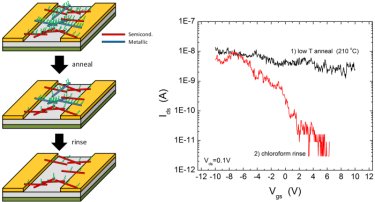Chloroform eliminates metallic CNTs
Come: Chinese Academy of Sciences Date: 2013-03-13 15:40:10
When single-walled carbon nanotubes are made, a mixture of both metallic and semiconducting nanotubes is produced. This is a problem when trying to make electronic devices from nanotubes because, ideally, either semiconducting or metallic tubes are needed depending on the application and not both. We have now developed a new approach based on thermal annealing of surface functionalized nanotube networks, followed by rinsing in chloroform, to selectively remove metallic carbon nanotubes (CNTs) from nanotube network devices. Metallic devices are thus turned semiconducting by physically removing the unwanted metallic tubes.
Our team of researchers at Sandia National Laboratories and Rice University has developed an approach to eliminate metallic CNTs from network devices by using alkyl functionalized CNTs. We have shown that thermal annealing of the alkylated CNT network devices at progressively higher temperatures results in a well-controlled transition from semiconducting to metallic behaviour as the CNTs de-alkylate. This is because the metallic CNTs are not only more heavily functionalized initially than the semiconducting CNTs but also because of the fact that they keep their surface functionalization at higher anneal temperatures compared to the semiconducting tubes.

Removing metallic CNTs
And, since heavily alkylated CNTs are more soluble in chloroform, this means that the metallic CNTs can be directly removed from network devices using a simple chloroform rinse. The result is that the CNT field-effect transistors with initial ION/IOFF ratios of less than 10 become semiconducting with ION/IOFF ratios of greater than 103.
The success rate of this technique is high. It is promising because it is a means to improve the performance of CNT arrays and network FETs using an “on-substrate” technique to remove metallic CNTs. The method can be applied to devices after fabrication on wafers, and including in the presence of electrical contacts.
More details can be found in the journal Nanotechnology.
< Previous Carbon nanoparticles in sea urchin la...CNT transistors detect cancer biomarkers Next >